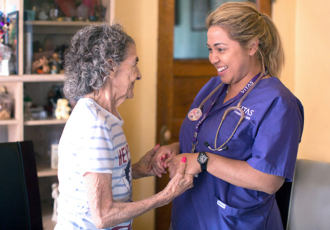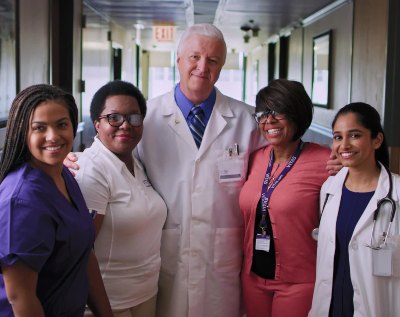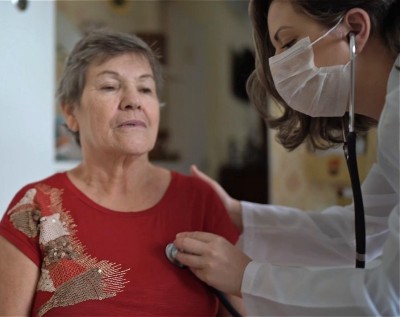Painting of VITAS Hospice Aide Captures Healthcare Workers’ Front-Line Experience

Alberto Carol, an artist and professor, painted “In the Frontline,” a portrait of VITAS Hospice Aide Lázara Hernández (shown in the photo at right) to convey what it is like working on the front lines of health care during the COVID-19 pandemic.
The eyes that peer out above the turquoise face mask are piercing and powerful, committed and compassionate, and yet anxious and scared.
The furrowed brow speaks to months of long hours, sick patients, and stress.
They are the blue eyes and burdened brow of VITAS Hospice Aide Lázara Hernández, a member of the Miami-Dade VITAS team since 2016 and the subject of a painting that has been selected for a month-long exhibit in New York on “Contemporary Realism.”
“What power has art!” Hernández wrote on painter Alberto Carol’s Facebook page in early September when she saw the striking oil-on-canvas creation, “In the Frontline,” for the first time.
A Portrait of Hernández Arriving Home from Work at VITAS
Equally powerful is the backstory about how a VITAS hospice aide in Miami was selected as a subject for artwork at a juried exhibition in Long Island, New York.
“Once I meet my patients and get to know them, my fear goes away, and I tell myself, ‘It’s time to get to work.’”
Hernández’ husband, Ismael Gomez Peralta, is a fellow painter and friend of Carol, who is a professor of drawing at the Fine Arts School of San Alejandro in Havana, Cuba. Both families are Cuban; Hernández left Cuba in 1999 for the United States and has worked as a nurse’s aide throughout South Florida.
Earlier this year, Carol reached out to Peralta and asked him to send a photograph of his wife because he knew she worked as on the COVID-19 front lines. Peralta snapped the photo one night as Hernández arrived home from work.
When she first saw the photo that her husband sent, Hernández remembers asking, “Why did you pick this photo of me? There are much prettier ones.”
His reply: “This one is much more intense.”
Indeed it is. Hernández says it captures perfectly the physical and emotional weight of working as a healthcare professional during a pandemic.
How She Helps Hospice Patients and Makes Them Smile
As a VITAS aide, Hernández provides personal care to hospice patients in their homes, nursing homes, and rehabilitation centers.
“Looking at the painting today makes me super happy,” she says. “I hope that people understand how stressed we are. We are constantly exhausted, and I hope by understanding that, they’ll take better care of themselves by following all of the recommended protections and safety precautions so that we can get rid of this virus.”
Each new assignment or new location, she says, resurrects new feelings of fear and anxiety.
“But once I meet my patients and get to know them, my fear goes away, and I tell myself, ‘It’s time to get to work, because I’ve got to do the best I can here,’” Hernández explains. “And after a while, I don’t even know why I was so scared.”
One of her greatest joys, she says, is seeing smiles break out on the faces of her patients—most of whom are incredibly sick or weak—as she talks to them, sings to them, and makes them as comfortable as possible.
On the painter’s Facebook page, Hernández wrote to Carol of her gratitude for the painting’s message and impact: “As a friend, you know the challenge of my work in health, and in my eyes, you have been able to successfully capture the situation that we face today, the emotions and feelings that overwhelm us. THANK YOU (for paying tribute) to all health personnel who work so hard on the front lines.”

Choose a Career with VITAS
We offer a variety of full-time, part-time and per-diem employment opportunities. Employees earn competitive salaries and have the flexibility to choose a benefits package suitable to their own needs and lifestyle.
See Current Opportunities
